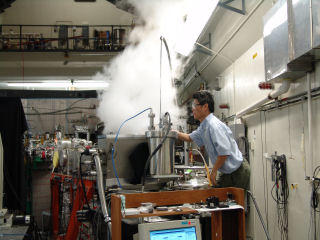Summary
To compare the calibration capabilities for the spectral responsivity in the vacuum-ultraviolet spectral region between 135 nm and 250 nm, PTB and NIST agreed on a bilateral comparison. Calibrations of semiconductor photodiodes as transfer detectors were performed using monochromatized synchrotron radiation and cryogenic electrical substitution radiometers as primary detector standards. Great importance was attached to the selection of suitable transfer detector standards due to their critical issues in that wavelength regime. The uncertainty budgets were evaluated in detail. The comparison showed a reasonable agreement between the participants. However, it got obvious that the uncertainty level for this comparison cannot easily be further reduced due to the lack of sufficiently radiation-hard and long-term stable transfer standard detectors.
Description

The last decade has seen numerous key comparisons in the field of photometry and radiometry between different national metrology institutes (NMIs) in the context of the Mutual Recognition Arrangement. At first, these comparisons were restricted to wavelengths longer than 200 nm, with just the exception of a recent pilot comparison from 10 nm to 20 nm. There are multiple reasons for this: The request for calibration techniques and certificates for wavelengths below 200 nm is limited to a small, but growing number of applications and research fields. Moreover, at shorter wavelengths, the practical problems of accurate measurements, i.e. source and detector stabilities, become an increasing challenge. As a result, only a few NMIs have calibration capabilities in the spectral regimes of the vacuum-ultraviolet (VUV), extreme ultraviolet (EUV) and, moreover, in the subsequent shorter wavelengths of the soft X-ray region. However, in these spectral regimes, the steadily growing interest in radiometric calibrations is driven by industries (e.g. photolithography) and research fields such as extraterrestrial solar astronomy.
Due to the lack of stable, tunable laboratory radiation sources in the VUV, the use of monochromatized synchrotron radiation (SR) is essential, though not widely available. While electrical substitution radiometers (ESRs) are well-established as primary detector standards in the optical regime, their operation in the VUV with the specific characteristics of SR is somehow more critical. Using SR of the storage rings SURF III (NIST) and BESSY II (PTB), both facilities offer regular calibration services for radiation detector devices with traceability to ESRs as primary standards. To validate the individual scales of spectral responsivity, we agreed to a bilateral comparison for the spectral region between 135 nm and 250 nm. A set of selected detectors had been calibrated by both participants, with PTB acting as pilot laboratory.

